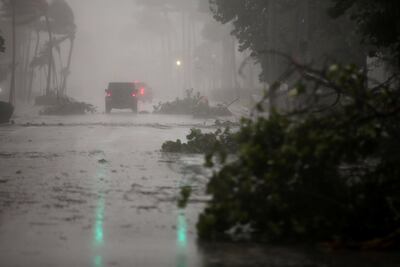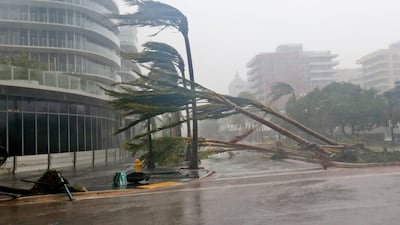A dark night gave way to a dark day as Hurricane Irma began its deadly assault on Florida on Sunday, slamming into the Florida Keys, sending sheets of rain squalling across the state and leaving the land in twilight.
The category four hurricane barrelled into the Keys with 215kph winds as tornadoes spiralled off its storm front further north.
"Pray for us," was the simple message from Rick Scott, the Florida governor, as he appeared on the Sunday morning news shows.
After hitting the southerly island chain, Irma was expected to track north taking its deadly trail of destruction up the western Gulf coast of Florida.
The National Weather Service in Key West issued a last minute warning for those who had decided to stay on the Keys.
“If you are here, please go to interior room away from windows,” it said. “Treat these imminent extreme winds as if a tornado was approaching and move immediately to the safe room in your shelter.
“Take action now to protect your life. You should already be taking cover.”
Residents had already been told by one local official that staying would be “almost like suicide”.
Some of those who refused to leave found rooms at the La Concha Hotel on Key West, thought to be one of the safest structures on the island.
"It's a little like the Titanic right now," Kim Sylar, a teacher and longtime resident told The Miami Herald before the storm arrived. "But I have a feeling it will be OK."
Elsewhere, Irma was making her force felt all across southern Florida.
In Fort Lauderdale, daylight never arrived. The city stayed in twilight beneath a grey sky which shed thick sheets of rain. Wind speeds hit 110kph in gusts, bending palm trees almost horizontal and stripping leaves from branches.
Authorities across the county extended an overnight curfew until Monday as they tried to keep roads clear for emergency services.
Throughout the night, residents’ phones buzzed with tornado warnings from the National Weather Centre as forecasters monitored spiralling storms splitting off the fast-moving hurricane front.
One water spout was caught on camera and a second twister was caught by radars smashing its way across land to the north of Fort Lauderdale.
At the Crossland Hotel guests watched nervously through storm-proof windows as the car park filled with rainwater.
Ostar Reyes, a roofer, said the rest of his family had headed north as Irma closed in but he was worried he would not be able to get home for weeks if he left.
“There was an evacuation order on my home so this seemed like the best place to come,” he said.
He had brought Layla, his six-month-old pit bull terrier, out of his room for a breath of fresh air. But she sat cowering at his feet in the face of the squalling rain.
“This is a bad one,” said Mr Reyes as he tried to comfort her.

In Miami, 70 kilometres to the south of Fort Lauderdale, local police warned residents they were on their own after 9am.
“Our officers are now sheltered for their safety. We cannot respond to calls for service. Stay indoors, DO NOT venture out,” they posted on Twitter.
Even so, the two cities have had a let-off. Irma’s late change of direction, an eleventh hour shift to west, has spared the eastern, Atlantic coast the worst of the devastation.
But authorities spent Sunday warning residents not to let down their guard.
The mayor of Miami Beach, Philip Levine, told CBS News This Morning that the centre of the storm — the eyewall — was not the only part of Irma that could inflict tremendous damage.
“The storm is so massive, it’s so huge it doesn’t make a difference if the actual core centre doesn’t go over Miami, Miami Beach,” he said. “We are still receiving and going to be receiving hurricane force winds and of course we are very concerned about the tidal surges.”
Residents of Miami’s high-rise towers were warned to stay away from the windows as winds began to hit 150kph.
Nearly seven people across the south-east were warned to get out of the storm’s path, including 6.4 million in Florida.
Mr Scott, the Republican governor, said he had spoken to President Donald Trump, and "everything I've asked out of the federal government, he's made sure he gave us".
He told NBC his main worry was storm surges which could reach as high as four-and-a-half metres in south-west Florida.
"It's hard to believe anybody will survive that," he said.
The governor has activated all 7,000 members of the Florida National Guard, and 30,000 guardsmen from elsewhere are also on standby.
Florida utility officials say more than one million customers had lost power by Sunday morning, a figure that is expected to rise. As many as nine million people may ultimately be without power. The Florida Power & Light company said it would have to completely rebuild part of its system, which would take weeks.

